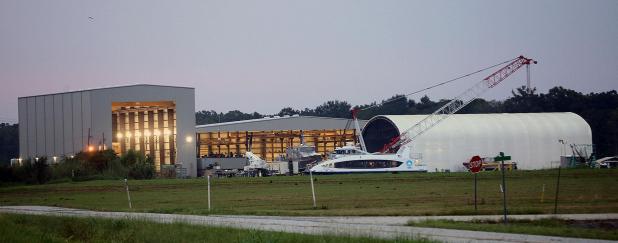
The Daily Review/Bill Decker
Metal Shark gets a positive mention in the Loren Scott economic forecast for 2020-21. The company, with its St. Mary shipyard, has grown from 40 employees to 300 since 2014 and has gone beyond the traditional oil and gas market into other types of vessels.
From the Editor: Economic forecast is bleak, but not hopeless
As a group, St. Mary Parish people work hard.
We work offshore, sometimes way offshore in Asia or Europe. We lug big hunks of steel around to make boats or fabricate complicated- looking equipment for the oilfield. We harvest sugar cane.
But nobody has a bigger job than Loren Scott.
He’s the economist emeritus at LSU. And every year, he develops an economic forecast for Louisiana.
Scott, assisted this year by Greg Upton and Judy S. Collins, has studied the state’s economy, the employment numbers, the finances, and the economic development wins and losses.
And he comes up with an economic forecast for the year ahead, an estimate of how well the state might do if nothing strange happens.
Something strange always happens.
Looking back over 50 years in our oil-and-gas-dependent state and parish, we’ve seen an Arab oil embargo that raised energy prices and brought in tons of cash. Then an Arab nation, Saudi Arabia, flooded the market with cheap oil, and bumper stickers asked the last person to leave Louisiana to please turn out the lights.
That market recovered slowly. But in 2005, hurricanes Katrina and Rita hit. Katrina, in particular, threatened the state economically by taking 25% of Louisiana’s commerce, the New Orleans part, off the board.
Federal relief money kept the state afloat for a while, so much money that the people who run Medicaid decided we should contribute more because we weren’t poor anymore.
Energy continued to recover, even blowing through the Great Recession on the way to $130 a barrel oil. Fracking took care of that, generating enough oil and gas to send the price of both spiraling down. And just when it seemed we’d reached some level of normality in employment and tax revenue, we got hit with the coronavirus.
How’d you’d like to make a prediction about a state like that? It’s like picking the winner in an LSU-Alabama football game.
Still, Scott is a trooper. He gave it the old college try with his recent forecast for 2020-21.
It doesn’t offer much in the way of giddy optimism. It’s not a complete downer, either.
The forecast is based on the assumption that the national economy will recover 72% of its COVID-19 losses next year and 100% by 2022. It also assumes that inflation and interest rates will remain low, and that oil prices will go to $49 by 2022, “a most uncertain forecast,” Scott says parenthetically.
Most of the forecast targets the state’s metropolitan statistical areas, lumping the other 29 parishes, including St. Mary, together as “the rural parishes.”
In those parishes, COVID aggravated the high unemployment that has been the rule since 2019 because of low oil prices, which clearly applies to St. Mary.
The 29 parishes lost 7,200 jobs this year, the forecast said. It predicts the rural parishes will pick up 4,000 jobs next year and 2,000 in 2022, leaving them down about 1,200 jobs from the COVID peak.
The two closest MSAs to St. Mary, Houma and Lafayette, may give some insight into the local recovery because they’re as energy-dependent as St. Mary.
Both the neighboring MSAs lost about 5.3% of their jobs in 2020 and continue to be hammered by low oil prices.
The forecast expects Houma to regain 2,500 jobs next year and 700 in 2022, leaving that region down about 1,300 jobs from its pre-COVID level.
Lafayette also got hurt by slumping energy prices, but it has an employment base that also includes high tech, health care and other non-energy sectors. The MSA to the west is expected to pick up 5,400 jobs next year and 1,800 in 2022, leaving Lafayette down 3,600 jobs from 2019.
Metal Shark of St. Mary gets some good ink in the report for its rapid expansion years, growing from 40 employees in 2014 to 300.
Shipyards as a whole have suffered with the decline in energy prices. The forecast points to three Bollinger shipyards in Morgan City and Amelia that have cut their payroll from 700 to 350 workers.
But boat-builders have begun to move away from dependence on serving the offshore oil industry and into other maritime pursuits.
Offshore Gulf energy activity has been hurt not just by low prices but by industry focus on the shale oil production that has more than doubled U.S. oil output since 2010.
But the money people who finance the fracking in places like the Permian Basin in west Texas and New Mexico were growing impatient with the return when oil was at $60 before COVID, the forecast said. It’s not likely they’ll be more satisfied with oil at about $40, where it is now.
“It is important to restate that these are the most uncertain forecasts we have ever produced,” the forecast summary says. “It is not difficult to create a scenario in which a quickly developed vaccine and more robust oil prices could pull the state out of the COVID chasm much more quickly.
“It is a prospect worthy of hope.”
Bill Decker is managing editor of The Daily Review.
